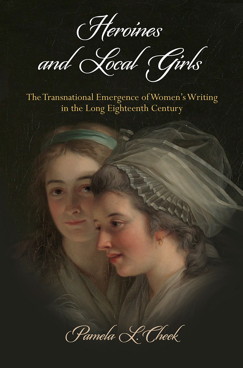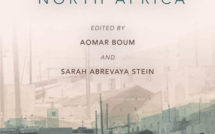
Heroines and Local Girls: The Transnational Emergence of Women’s Writing in the Long Eighteenth Century by Pamela L. Cheek

This is part of our special feature, Me Who? The Audibility of a Social Movement.
This deeply researched book provides a much-needed transnational history of the emergence of women’s writing as a distinct body of literature through an analysis of both the writerly and readerly approaches that facilitate intra-sexual and textual community-building. It seeks to elucidate the strategies that favor the move from the identification of the individual female reader with a work of literature to the consolidation of a collective subsection of women’s writing. What was it about certain types of writing that prioritized gender and overrode—or at least minimized—affiliation based on class or social rank? Heroines and Local Girls seeks to locate the networks and reciprocal influences of women authors writing in France, Germany, Holland and England; it repeatedly posits the existence of “horizontal” disseminations or synchronic paradigms of comparative writerly approaches adopted by women authors in contrast to a “vertical” lineage of literary forefathers passing on the beacon of originality to their successive sons.
Throughout the eighteenth century, women’s writing was produced by exceptional women who often had to look beyond national borders in order to find other female kindred spirits. Translation obviously played a key role in allowing women from different countries to access foreign works—works that themselves were often translated by women—thus exposing them to national differences in gender norms. Translation is also a fundamentally relational gesture in that it seeks to broaden the readership of texts and to bridge national differences, thereby positing a potential sense of community among women readers based on the belief that “women understood the meanings of other women, regardless of linguistic differences” (155). It was also seen as a derivative form of writing and thus one suitable for women, yet translating texts gave women financial independence, access to the public domain and insight into other national cultures. While alert to the dangers of homogenization, of presenting women’s writing as a transnational category that obscures intersectional differences of race, sexuality or geography, Pamela L. Cheek suggests that, already by the 1780s, women writers perceived themselves as part of a transnational community of writers. She emphasizes the numerous examples of different genres and fora for women’s writing that posited a set of shared codes: women’s journals, for example, promoted a textual space where women could write and read female-authored production, and networks of women writers promoted transnational links and similarities between local women authors of different origins.
The first two chapters of the book focus on the emergence of the practice of women’s writing, or on the conditions that facilitated the consolidation of a niche-marketed commercial phenomenon that appealed to a specific readership. The fact that the key topic of women’s writing was overwhelmingly women’s ongoing battle to preserve their virtue meant that women’s writing forged a “non-national but nation-like literary identity: virtuous womanhood” (20). As Cheek puts it, many of the most exceptional women writers working and publishing in Europe at the time saw themselves as a group “characterized at once by national differences and by transnational connections” (26). Heroines and Local Girls provides both broad international contextualization in which Cheek surveys the secondary criticism that has sought to trace female literary networks across Europe and engages in close critical readings itself. Cheek also examines the role of the literary market place and women’s self-positioning within it in the late seventeenth century as contributing to the circumstances that led to the establishment of literature as an autonomous field, rather than one presided over by a set of wealthy patrons. And it was a field that promoted cultural transfer across national boundaries thanks to translators, educated women authors, European book fairs and booksellers. Women and girls across national borders formed imaginary communities of readers, united by the practice of producing and consuming literature. As Cheek remarks: “The capacity to read in a second language and the capacity to translate allowed literate eighteenth-century women to coalesce into a multilingual market sector and ‘community of practice’ for and within a transnational print culture” (35). Women readers engaged in virtual learning communities about virtue that did not depend on the physical presence of others. Cheek innovatively uses contemporary theorists such Pierre Bourdieu and Étienne Wenger to offer insightful interpretations about reading and writing ideational communities of women and the works of art that mattered to them. These works offered women readers role models or heroines to be emulated. The literary representations of local girls subjected to localized gender norms and exemplary heroines who had successfully transcended them encouraged readers to believe in a general notion of the commonality of women’s experience.
Early chapters in the book highlight the particularity of establishing a genealogy and emergence of women’s writing, given its lack of “vertical” lineage of literary greats: one [i.e. male authors] typically looks back to the Ancients to emphasize one’s own continuity and difference within the field of literary production. It may be that the critical interest in the lives of women writers, the tendency to associate the female protagonist with the female author, meant that women’s literary production was perceived as somehow more grounded in an extratextual reality—one is reminded of the American critic Mary Ellmann’s famous quotation in her seminal work, Thinking about Women (1968): “Books by women are treated as though they themselves were women, and criticism embarks, at its happiest, upon an intellectual measuring of busts and hips.”[i] Women were bound by transnational, horizontal “force fields” rather than by a vertical Bloomian anxiety of influence, through literary and conversational affinities rather than “textual inheritance and reaction” (47). While men often imparted advice through the hierarchical relationship of master and mentee, women shared spaces of sociability in the domestic realm – including the garden – with conversational companions, one of whom often acted as the exemplum that all others sought to emulate. In particular, the book describes a literary “city of women,” exceptional individuals whose very extraordinariness lifted them out of national contexts and allowed them to inhabit “the same imaginative space” (64). Cheek looks at the work of some of these exceptional women in detail, such as Anna Maria van Schurman or Madeleine de Scudéry. She comments on the increasingly popular convention of women reading women’s literature to other women, thereby uniting the written and the conversational and, once again, bridging the textual and the real with an emphasis on female experience and representations of virtue, rather than a valorization of specific aesthetic qualities.
The reach of the European literatures examined in Heroines and Local Girls is impressive. In later chapters, Cheek looks closely at specific national examples of women’s writing by focusing on two protorealist novels, Charlotte Lennox’s The Female Quixote (1752) and Françoise de Graffigny’s Lettres d’une Péruvienne (1747), and at a range of pedagogical treatises from Britain and Western Europe. She harnesses the narratives of these novels to demonstrate her argument that the eighteenth century saw rise up a literary “city of women where companions in misfortunes [could] share their stories and have them credited” (114), where the affirmation and protection of female sexual virtue was evidence of a psychological fortitude and one shared with other women that they might feel an affinity with it. In many novels, the “conversational sharing of personal stories of gendered calamity is an inherited and constitutive code of women’s writing” (120), a sharing that also takes place between the book and the reader, most obviously so when books were read aloud. Girls’ participation in collective acts of reading, in which the presence of numerous others constituted an implicit vetting and approving of the content of the text, was promoted by multiple artistic genres: “Conduct literature, novels, paintings, and engravings contrasted the potential dangers of silent solitary reading for women with the benefits of coming into contact with print in collective oral contexts” (125). The educator Madame de Maintenon actually devised model conversations for her students at Saint-Cyr that could be read aloud for instructional purposes, thereby blurring the line between the literary and the pedagogical. The closing years of the eighteenth century saw less novelistic focus on the extraordinary national heroine as exemplum but a more chronologically and geographically specific “local girl” who none the less possessed a “supranational affinity” (171) that allowed her to triumph over gendered oppression thanks to her reading habits, cultural awareness and espousal of reason. Or else the focus was on an internationally hybrid protagonist who turned out to be of mixed, often socially superior, parentage, hence the local girl was the exceptional heroine, as in Charlotte Smith’s Celestina (1791). The book also explores Germaine de Staël’s Corinne ou L’Italie (1807) and Frances Burney’s The Wanderer, or Female Difficulties (1814), reading them as “antisentimental novels […] that […] mourn the end of the age of the hybrid heroine” (196), who does not conform to evolving (Napoleonic) national types that prefer women to be domesticated but is, instead, an independent woman in exile who refuses to remain invisible. In other words, alongside “conversational sociability and conversancy with modern European languages” (206), (political) “displacement from place or country of birth”, ibid., subsequently facilitated a forging of the phenomenon of women’s writing as a transnational literary field.
This is a wide-ranging, meticulously detailed book that is densely packed with important insights. That density is further mirrored in its expression, which can make it quite a demanding work to read, both syntactically and content-wise. Cheek at times employs rather opaque nouns that call for greater qualification – “Women writers relied on the devices of the novel of sympathy and sentiment to highlight the gender roles supposed to be typical of particular nations or regions” (163) —or peppers her sentences with intervening clauses that benefit from rereading: “It [the women’s novel] cultivated affinity among readers on the basis of a demonstration that the most exceptional woman might triumph above, or at least record in writing, like the unnamed narrator of The History of Ernestine or Arabella Fermor in The History of Emily Montague, the cultural rites of womanhood” (177). These are none the less minor stylistic points – and no doubt the result of having an abundance of interesting material to convey – in what remains an erudite study of real critical significance.
Siobhán McIlvanney is Reader in French and Francophone Women’s Writing at King’s College London. She has recently published a monograph on the early French women’s press, Figurations of the Feminine in the Early French Women’s Press, 1758-1848 (2019) and co-edited a volume of essays on women and the city, Women and the City in French Literature and Culture: Reconfiguring the Feminine in the Urban Environment (2019).
Heroines and Local Girls: The Transnational Emergence of Women’s Writing in the Long Eighteenth Century
By Pamela L. Cheek
Publisher: University of Pennsylvania Press
Hardcover / 280 pages / 2019
ISBN: ISBN 9780812251487
[i] Thinking About Women (New York: Hardcourt, Brace & World: 1968), p. 29.
Published on March 10, 2020.




